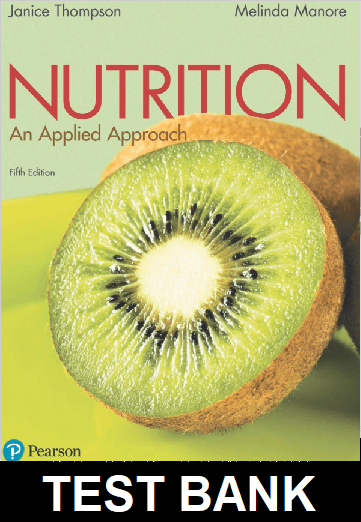Test Bank For Nutrition An Applied Approach 5th Edition Thompson
Digital item No Waiting Time Instant DownloadISBN: 9780134564487
In Stock
Original price was: $75.00.$45.00Current price is: $45.00.
Test Bank For Nutrition An Applied Approach 5th Edition Thompson
Nutrition: An Applied Approach, 5e (Thompson/Manore)
Chapter 3 The Human Body: Are We Really What We Eat?
Multiple Choice Questions
1) Which hormones are responsible for maintaining blood glucose levels?
A) testosterone and estrogen
B) leptin and ghrelin
C) glucagon and insulin
D) epinephrine and CCK
Answer: C
Diff: 2
Skill: Remembering/Understanding
Learning Outcome: 3.2
Chapter/Section: 3.2
2) Appetite is triggered by
A) a physiological drive.
B) environmental cues, such as the smell or taste of food.
C) pancreatic enzymes.
D) stomach enzymes.
Answer: B
Diff: 1
Skill: Remembering/Understanding
Learning Outcome: 3.2
Chapter/Section: 3.2
3) Which physiological stimulus will trigger the sensation of hunger?
A) low glucose levels
B) high glucose levels
C) release of the hormone leptin
D) eating a meal with a high satiety value
Answer: A
Diff: 4
Skill: Applying/Analyzing
Learning Outcome: 3.2
Chapter/Section: 3.2
4) Hunger is best described as
A) a physiological desire to consume food.
B) a psychological desire to consume food.
C) eating that is often driven by environmental cues.
D) eating that is often driven by emotional cues.
Answer: A
Diff: 2
Skill: Remembering/Understanding
Learning Outcome: 3.2
Chapter/Section: 3.2
5) Assuming the Calories and relative sizes are similar, which of the following snacks will have the highest satiety value?
A) two saltine crackers spread with jam
B) two saltine crackers spread with butter
C) a glass of orange juice
D) a hard-boiled egg
Answer: D
Diff: 3
Skill: Applying/Analyzing
Learning Outcome: 3.2
Chapter/Section: 3.2
6) Which type of cells form the lining of the small intestine?
A) parietal cells
B) enterocytes
C) chief cells
D) melanocytes
Answer: B
Diff: 1
Skill: Remembering/Understanding
Learning Outcome: 3.1
Chapter/Section: 3.1
7) The smallest units of matter that normally CANNOT be broken down are
A) atoms.
B) molecules.
C) cells.
D) phospholipids.
Answer: A
Diff: 1
Skill: Remembering/Understanding
Learning Outcome: 3.1
Chapter/Section: 3.1
8) The human body is organized into the following structural levels (smallest to largest)
A) molecules, atoms, organs, systems, tissues, cells.
B) atoms, molecules, cells, tissues, organs, systems.
C) organs, tissues, molecules, systems, atoms, organ.
D) atoms, cells, systems, tissues, molecules, organs.
Answer: B
Diff: 4
Skill: Applying/Analyzing
Learning Outcome: 3.1
Chapter/Section: 3.1
9) Our genetic information, in the form of deoxyribonucleic acid (DNA), is located in the
A) endoplasmic reticulum (ER).
B) mitochondria.
C) nucleus.
D) cytoplasm.
Answer: C
Diff: 2
Skill: Remembering/Understanding
Learning Outcome: 3.1
Chapter/Section: 3.1
10) Cell membranes are primarily composed of two layers of
A) sugars.
B) phospholipids.


Reviews
There are no reviews yet.